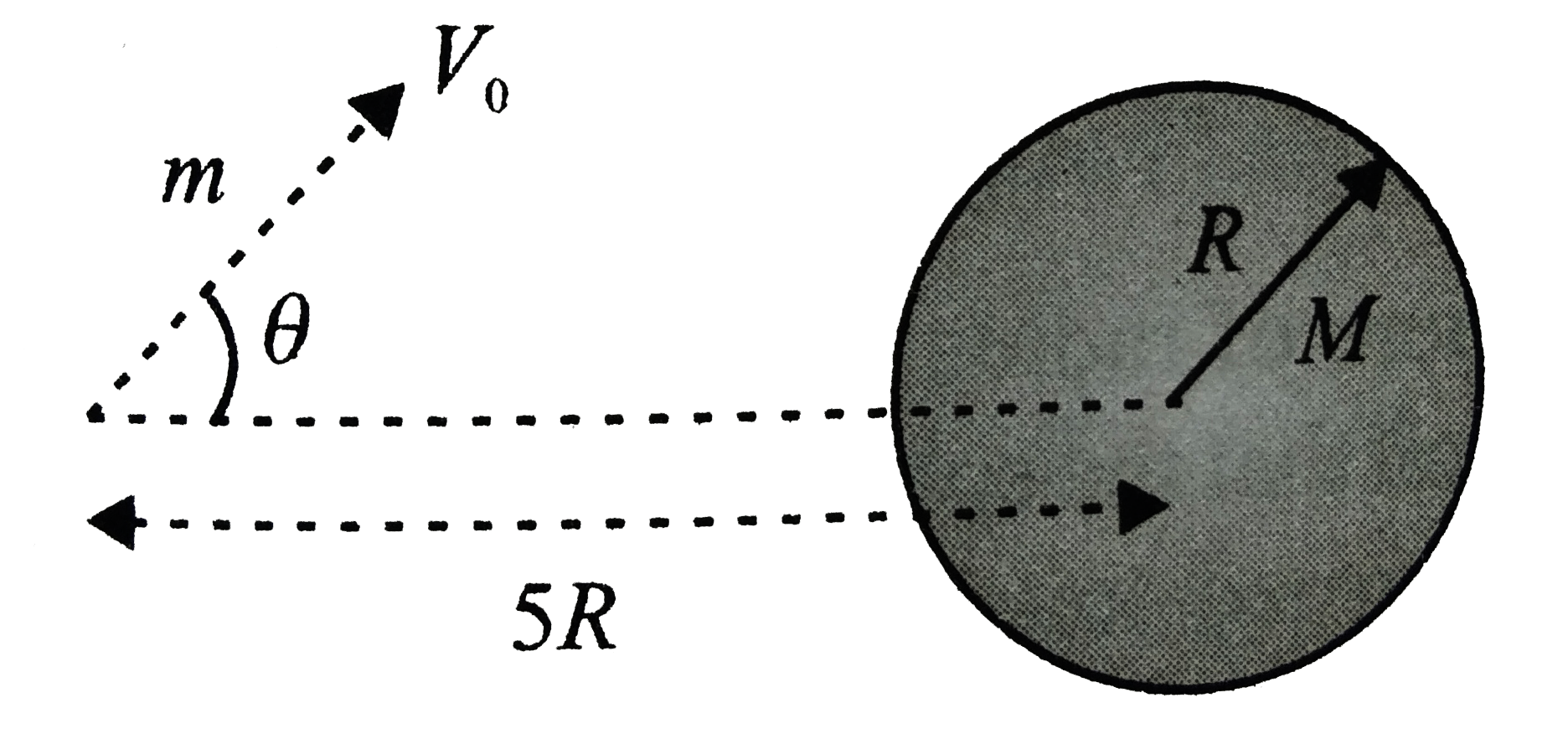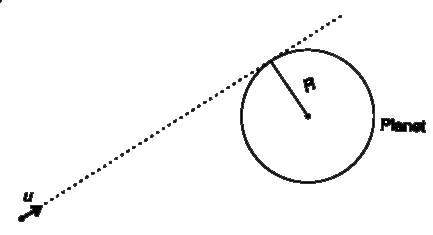A spaceship is sent to investigate a planet of mass M and radius R. While hanging motionless in space at a distance 5R from the centre of the planet, the spaceship fires an instrument package of mass m, which is much smaller than the mass of the spaceship. For what angle θ will the package just graze the surface of the planet?

The correct Answer is:sin−1(15√1+8GM5v20R))
Let the speed of the instrument package be v when it grazes the surface of the planet.

Conserving angular momentum of the package about the centre of the planet
mv0×5Rsintη=mvR
⇒v=5v0sinθ
Conserving mechanical energy, we get ...........i
−GMm5R+12mv20=−GMmR+1wmv2
⇒12m(v2−v20)=4GMm5R
⇒v2=v20=8GM5R..............ii
Substituting the value of v from eqn i in Eqn ii we have
25v20sinθ−v20=8GM5R
⇒θ=sin−1⎛⎝15√1+8GM5v20R⎞⎠
Topper's Solved these Questions
- BOOK - CENGAGE PHYSICSCHAPTER - GRAVITATIONEXERCISE - Single Correct122videos
GRAVITATION
- BOOK - CENGAGE PHYSICSCHAPTER - GRAVITATIONEXERCISE - Multiple Correct24videos
GRAVITATION
- BOOK - CENGAGE PHYSICSCHAPTER - GRAVITATIONEXERCISE - Exercise 6.416videos
GRAVITATION
- BOOK - CENGAGE PHYSICSCHAPTER - FLUID MECHANICSEXERCISE - INTEGER_TYPE1videos
FLUID MECHANICS
- BOOK - CENGAGE PHYSICSCHAPTER - KINEMATICS-1EXERCISE - Integer9videos
KINEMATICS-1
Similar Questions

A small asteroid is approaching a planet of mass M and radius R from a large distance. Initially its velocity (u) is along a tangent to the surface of the planet. It fall on the surface making an angle of 302 with the vertical. Calculate u.View SolutionThe earth is a homogeneous sphere of mass M and radius R. There is another spherical planet of mass M and radius R whose density changes with distance r from the centre as p=p0r. (a) Find the ratio of acceleration due to gravity on the surface of the earth and that on the surface of the planet. (b) Find p0.
View Solution
Knowledge Check
- Question 1 - Select One or More
A particle at a distance r from the centre of a uniform spherical planet of mass M radius R (ltr) has a velocity of magnitude v.
Afor 0<v<√GMr trajectory may be ellipseBfor v =√GMr trajectory may be ellipseCfor √GMr<v<√2GMr trajectory may be ellipse.Dfor v =sqrt((GM)/r trajectory may be circle - Question 2 - Select One
The angular velocity of rotation of a planet of mass M and radius R, at which the matter start to escape from its equator is
A√2GMR3B√2GMRC√2G2MRD√2GM2R - Question 3 - Select One
A space vehicle approaching a planet has a speed v when it is very far from the planet At that moment tangent of its trajectory would miss the centre of the planet by distance R if the planet has mass M and radius r what is the smallest value of R in order that the resulting orbit of the space vehicle will just miss the surface of the planet?
AR=rv[v2+2GMr]1/2BR=vr[1+2GMr]CR=vr[v2+2GMr]DR=2GMvr
A space vehicle approaching a planet has a speed v when it is very far from the planet At that moment tangent of its trajectory would miss the centre of the planet by distance R if the planet has mass M and radius r what is the smallest value of R in order that the resulting orbit of the space vehicle will just miss the surface of the planet?
View SolutionIf ve is the escape velocity of a body from a planet of mass 'M' and radius 'R. Then the velocity of the satellite revolving at height 'h' from the surface of the planet will be
View SolutionA body of mass m at inifnity is approaching the centre of a hypothetical hollow planet of mass M and radius R. The speed of the body when it passes the centre of the planet through a diametrical tunnel is
View SolutionA planet has a mass M1 and radius R1. The value of acceleration- due to gravity on its surface is g1. There is another planet 2, whose mass and radius both are two times that of the first planet. Which one of the following is the acceleration due to gravity on the surface of planet 2?
View SolutionAt satellite of mass m is launched from the surface of a planet of mass M and radius R in a circular orbit at an altitude of 3R. K.E. of satellite at the time of launching is
View Solution

